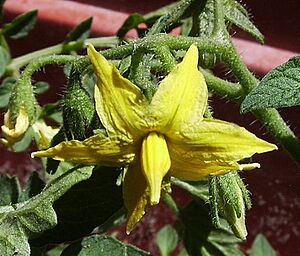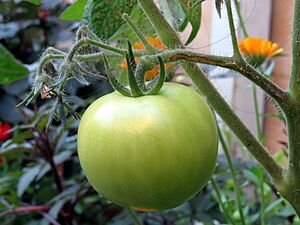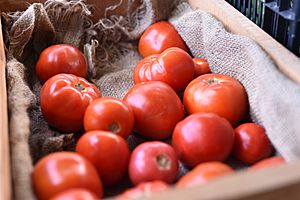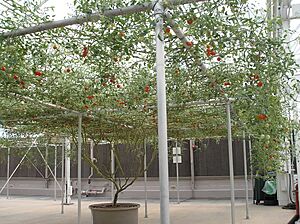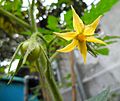Tomato facts for kids
Quick facts for kids Tomato |
|
|---|---|
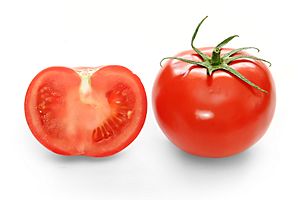 |
|
| Cross-section and full view of a hothouse (greenhouse-grown) tomato | |
| Scientific classification | |
| Kingdom: | |
| (unranked): | |
| (unranked): | |
| (unranked): | |
| Order: | |
| Family: | |
| Genus: |
Solanum
|
| Species: |
S. lycopersicum
|
| Binomial name | |
| Solanum lycopersicum |
|
| Synonyms | |
|
Lycopersicon lycopersicum (L.) H. Karst. |
|
The tomato (Solanum lycopersicum) is a type of fruit that grows on a plant. Even though it's a fruit by science rules, most people use it like a vegetable in cooking.
Tomatoes are usually shiny and smooth. They have many small seeds inside. They are also very good for your health! Most tomatoes are red when they are ripe. When they are still growing, they are green. As they get ripe, they turn red and get bigger. There are many different kinds of tomatoes. Some types can be yellow or orange when they are ready to eat. Tomatoes are used a lot in Italian food. They are also a main ingredient in ketchup.
Tomatoes are called fruits because they contain seeds. These seeds are spread when animals eat the tomato. The seeds then pass through the animal's digestive system.
Contents
Tomato History
The tomato plant first grew in western South America. The wild tomatoes were small, like today's cherry tomatoes. They were probably yellow, not red. The Spanish explorers brought tomatoes to Europe. People in Spain and Italy started using them in their food.
However, people in France and northern Europe thought tomatoes were poisonous. This was because tomatoes are part of the deadly nightshade plant family. The leaves and unripe fruit of a tomato plant have a substance called tomatine. In large amounts, tomatine can be harmful. But don't worry, ripe tomatoes do not have tomatine!
What Does a Tomato Plant Look Like?
Tomato plants are like vines. They can grow very tall, often over 180 centimeters (6 feet) if they have support. Some types are bred to be shorter, like bushes, usually around 100 centimeters (3 feet) tall. In warm places, tomato plants can live for a few years. In colder areas, they usually die each year.
Tomato plants have many branching stems. The very tip of a stem does most of the growing. If the tip stops growing, other parts of the plant will start to grow new vines.
Tomato vines often have fine, short hairs. These hairs help the plant grow. They can even turn into roots if the vine touches the ground and gets wet. This helps the plant get more water and nutrients.
Most tomato plants have compound leaves. This means each leaf is made up of several smaller leaflets. These leaves are usually 10 to 25 centimeters (4 to 10 inches) long. Each leaflet can be up to 8 centimeters (3 inches) long and has a jagged edge. Both the stems and leaves are quite hairy.
Their small, yellow flowers are about 1 to 2 centimeters (0.4 to 0.8 inches) wide. They have five pointed parts. These flowers often grow in groups of three to twelve. In many types of tomatoes, the flowers can fertilize themselves.
The tomato fruit itself is a berry in scientific terms. It grows from the flower after it is fertilized. The fruit has hollow spaces inside called locular cavities. These spaces are full of seeds and moisture. Smaller tomatoes usually have two cavities. Round tomatoes often have three to five. Large "beefsteak" tomatoes have many small cavities.
To grow new tomato plants from seeds, the seeds need to come from a ripe fruit. They should be lightly fermented to remove a jelly-like coating. Then, they need to be dried before you plant them.
Is a Tomato a Fruit or a Vegetable?
This is a common question! From a science point of view, a tomato is a fruit. It is a berry, which means it grows from the flower's ovary and contains seeds.
However, in cooking, tomatoes are usually called "culinary vegetables." This is because they have less sugar than most fruits. They taste more savory than sweet. So, people usually eat them in salads or main meals, not as a dessert. Many other foods are also botanically fruits but cooked as vegetables. These include bell peppers, cucumbers, green beans, eggplants, avocados, and different kinds of squash like zucchini and pumpkins.
The question of whether a tomato is a fruit or a vegetable even went to court in the United States! In 1887, there were laws about taxes on vegetables, but not on fruits. So, it became important to decide what a tomato was. In 1893, the U.S. Supreme Court decided that for tax purposes, a tomato was a vegetable. They based this on how people commonly use it: tomatoes are usually served with dinner, not dessert. This ruling only applied to tax laws, not to how scientists classify tomatoes.
Growing Tomatoes
Tomatoes are grown all over the world because their fruits are good to eat. There are thousands of different types, called cultivars. Gardeners often use special fertilizers for tomatoes. These fertilizers help the plants grow strong. Manure and compost are also good for tomato plants. On average, there are about 150,000 seeds in one pound of tomato seeds.
Tomato Records
As of 2008, the heaviest tomato ever picked weighed 3.51 kilograms (7 pounds, 12 ounces). It was a "Delicious" type tomato. Gordon Graham grew it in Edmond, Oklahoma, in 1986. The longest tomato plant was a "Sungold" type. It grew to 19.8 meters (65 feet) long! Nutriculture Ltd in the UK grew it in 2000.
A huge "tomato tree" grew in the experimental greenhouses at Walt Disney World Resort in Florida. This plant might have been the biggest single tomato plant in the world. It was recognized by Guinness World Records. It produced over 32,000 tomatoes, weighing a total of 522 kilograms (1,150 pounds). This single vine gave thousands of tomatoes at once. Yong Huang, a science manager at Epcot, found this special plant in China. He brought its seeds to Epcot and created a special greenhouse for it. The plant grew tomatoes about the size of a golf ball. These tomatoes were served in Walt Disney World restaurants. Sadly, the plant got sick and was removed in April 2010 after about 13 months.
How We Use Tomatoes
Cooking with Tomatoes
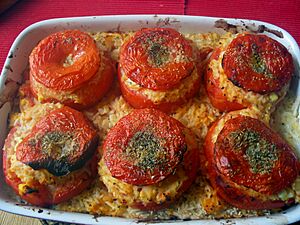
Even though it's a fruit, the tomato is used like a vegetable in cooking. It has a strong, savory taste called umami, not a lot of sweetness. Some studies have shown that the inside pulp of a tomato has much more umami flavor than the outer flesh.
Tomatoes first came from the Americas, but now people eat them all over the world. You can use them in many ways. You can eat them raw in salads or in slices. You can stew them or add them to many different dishes. Tomatoes are also made into ketchup or tomato soup. Unripe green tomatoes can be fried, used to make salsa, or pickled. Tomato juice is sold as a drink and used in cocktails like the Bloody Mary.
Tomatoes are very important in Mediterranean cuisine. They are a key ingredient in pizza and many pasta sauces. Tomatoes are also used in Spanish and Catalan dishes, such as gazpacho and pa amb tomàquet.
Storing Tomatoes
Tomatoes stay fresh best when they are not washed. Keep them at room temperature and out of direct sunlight. It is not a good idea to put them in the refrigerator. This can make them feel mealy and lose their flavor.
Storing tomatoes with the stem side down can help them last longer. This might stop them from rotting too quickly. If you have unripe tomatoes, you can put them in a paper bag to help them ripen.
Tomatoes are easy to save for later. You can preserve them whole, chopped, or as tomato sauce or concentrated paste. This can be done by home canning. You can also dry the fruit, sometimes in the sun. Dried tomatoes are sold in bags or in jars with oil.
Tomato Nutrition
| Nutritional value per 100 g (3.5 oz) | |
|---|---|
| Energy | 74 kJ (18 kcal) |
|
3.9 g
|
|
| Sugars | 2.6 g |
| Dietary fiber | 1.2 g |
|
0.2 g
|
|
|
Protein
|
0.9 g
|
| Vitamins | Quantity
%DV†
|
| Vitamin A equiv.
beta-Carotene
lutein zeaxanthin
|
5%
42 μg
4%
449 μg123 μg
|
| Thiamine (B1) |
3%
0.037 mg |
| Riboflavin (B2) |
2%
0.019 mg |
| Niacin (B3) |
4%
0.594 mg |
| Pantothenic acid (B5) |
2%
0.089 mg |
| Vitamin B6 |
6%
0.08 mg |
| Folate (B9) |
4%
15 μg |
| Vitamin C |
17%
14 mg |
| Vitamin E |
4%
0.54 mg |
| Vitamin K |
8%
7.9 μg |
| Minerals | Quantity
%DV†
|
| Calcium |
1%
10 mg |
| Iron |
2%
0.27 mg |
| Magnesium |
3%
11 mg |
| Manganese |
5%
0.114 mg |
| Phosphorus |
3%
24 mg |
| Potassium |
8%
237 mg |
| Sodium |
0%
5 mg |
| Zinc |
2%
0.17 mg |
| Other constituents | Quantity |
| Water | 94.5 g |
| Lycopene | 2573 μg |
|
Link to USDA Database entry
|
|
| †Percentages estimated using US recommendations for adults. | |
A raw tomato is mostly water, about 95%. It has about 4% carbohydrates. It has less than 1% each of fat and protein. A 100-gram (3.5-ounce) serving of raw tomatoes gives you 18 kilocalories. They are a good source of vitamin C, providing 17% of the daily recommended amount. Other micronutrients are present in smaller amounts.
Related pages
Images for kids
-
Tomatoes being collected from the field, Maharashtra, India
-
Tomatoes thrown from a truck during the Spanish Tomatina festival.
See also
 In Spanish: Solanum lycopersicum para niños
In Spanish: Solanum lycopersicum para niños


